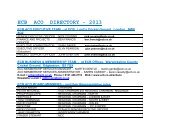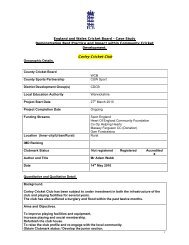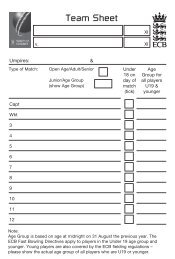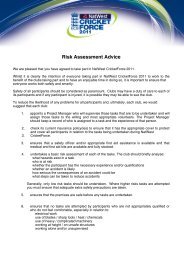Developing a Project â From Concept to Completion - Ecb - England ...
Developing a Project â From Concept to Completion - Ecb - England ...
Developing a Project â From Concept to Completion - Ecb - England ...
- No tags were found...
You also want an ePaper? Increase the reach of your titles
YUMPU automatically turns print PDFs into web optimized ePapers that Google loves.
4Getting Support6Consultant ServicesThe ECB Funding and FacilitiesUnit (FFU) should be your first poin<strong>to</strong>f call for advice. You should makecontact with the FFU during work stageA, as outlined in section 8, and showthem your project (refer <strong>to</strong> contactspage 13). Consulting the ECB at theearliest opportunity allows their input <strong>to</strong>be more valuable.5Local CommunitiesGood communication with the localcommunity is important. Potentially itcould lessen objections <strong>to</strong> your planningapplication and help <strong>to</strong>wards a smoothrelationship with neighbours before,during and after construction. Peoplecan be sensitive <strong>to</strong> change so it’sworth finding ways <strong>to</strong> keep neighboursinformed. This could have surprisingand beneficial results, for example oneFunding and planning permission aretwo important hurdles in the preparationand design stages of a project. The ECBRegional Funding and Facilities Managerwill assess the proposals for technicalcompliance, sports development andfinancial affordability.club arranged temporary contrac<strong>to</strong>r’saccess through adjacent land whichmade larger deliveries possible andshortened the construction period.Good links with the local communityalso provides the opportunity <strong>to</strong> makecontact with new members. One way ofcommunicating is <strong>to</strong> develop a masterplan of the site inclusive of all your futureplans (see example below).If the appropriate skills are not availablewithin the project team, you may need<strong>to</strong> engage the services of specialists,as follows:Building <strong>Project</strong>s (including renovationand refurbishments)1 ArchitectArchitects design new buildings,the spaces around them andalterations <strong>to</strong> existing buildings.They also advise on the res<strong>to</strong>rationand conservation of old buildings,layouts for groups of buildingsand most of what is referred <strong>to</strong> asthe built environment. They liaisewith current users, clients, andconstruction specialists and theirdesigns take account of informationabout cost, safety and socialfac<strong>to</strong>rs from other specialists inthe team. They advise clients onthe practicality of building projectsand seek permission and approval<strong>to</strong> see if the proposals can be putin<strong>to</strong> practice. Once building startsthey can coordinate and administerthe building contract through<strong>to</strong> completion. Refer <strong>to</strong> RIBACommissioning Architecture leafletand websitewww.architecture.com/UseAnArchitect.2 Structural EngineerStructural engineers design andcalculate the building structure andfoundations. They sometimes alsodesign below ground drainage.Refer <strong>to</strong> www.istructe.org3 Mechanical and Electrical (M&E)Services EngineerM&E services engineers design andcoordinate the services of buildingsincluding gas, electricity, heating,lighting, ventilation, water andrenewable energy. They sometimesalso design the drainage. Theycalculate the proposed energy useof the buildings.Refer <strong>to</strong> www.cibse.org4 Quantity SurveyorQuantity surveyors measure,estimate and advise on the cost ofthe designs produced by architects,structural engineers and servicesengineers. www.RICS.org5 Construction DesignManagement(CDM) Coordina<strong>to</strong>rCDM coordina<strong>to</strong>rs advise clients onhealth and safety issues, risks andthe competency of the design team.This is applicable across all projectthemes. They must be appointed bywork stage C/ concept design, asoutlined in section 8.4 <strong>Developing</strong> a <strong>Project</strong> – <strong>From</strong> <strong>Concept</strong> <strong>to</strong> <strong>Completion</strong><strong>Developing</strong> a <strong>Project</strong> – <strong>From</strong> <strong>Concept</strong> <strong>to</strong> <strong>Completion</strong> 5












![Indoor Sports Halls with Cricket Provision [TS3] - Ecb - England and ...](https://img.yumpu.com/49070696/1/190x135/indoor-sports-halls-with-cricket-provision-ts3-ecb-england-and-.jpg?quality=85)



